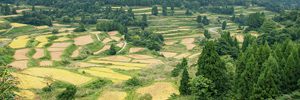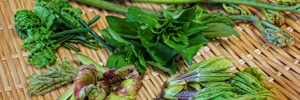
Tokamachi—Beautiful nature and warm humanity
Tokamachi City is located in southern Niigata Prefecture. With the Shinano River flowing through the center, the city consists of a basin and surrounding hilly and mountainous areas, and is designated as a special snowy area with three to four meters of snow each winter. Rice is cultivated widely in the city, a production area of well-known Uonuma Koshihikari rice. The city also features a woven fabric culture, which used to be as thriving as the Nishijin district in Kyoto. Kiyotsu Gorge, located in the south, is one of the three great gorges in Japan, and also a national designated site of scenic beauty and natural treasure. Matsunoyama Onsen in the west is one of the three major medicated baths in Japan.
Since the 2000s, every three years the city has also hosted the "Echigo-Tsumari Art Triennale: Art Festival of the Earth," one of the largest art festivals in the world. "Echigo-Tsumari" is not an actual name on the map but a new name for the specific region that includes Tokamachi City and Tsunan Town. The name comes from the fact that this area was called "Tsumari-go" in ancient times and is becoming widely known in Japan and abroad.
Culture and Nature in Tokamachi City

Tokamachi Kimono Festival
To celebrate our kimono culture, this festival is held every year on May 3, the same day as the coming-of-age ceremony in Tokamachi at Cross-ten. The town is filled with people in colorful kimonos.

Bijin-bayashi (beauty forest)
This is a forest of still young beech trees aged 80 to 90 years old. The forest is called Bijin-bayashi (forest of beauty) because the young slender trees standing elegant and graceful remind people of beautiful women, and attracts many photography enthusiasts and bird watchers.

Echigo-Tsumari Art Triennale:
Art Festival of the EarthThis festival of contemporary arts is held every three years in the satoyama (cultivated countryside) in the Echigo-Tsumari region (Tokamachi City and Tsunan Town). Many artworks are exhibited on rice fields, along the eaves of private houses, and in empty houses, among other places.

Tanada (rice terraces)
Many beautiful rice terraces still remain in the Matsudai and Matsunoyama areas. They console the hearts of visitors as reminiscent landscapes of unspoiled countryside.

Mountain Gorges
Scenic spots for enjoying the grand beauty of gorges are dotted along rivers flowing into the great Shinano River, including Kiyotsu Gorge (one of the three great gorges in Japan) and Tashiro-no-Nanatsugama (seven waterfall basins of Tashiro), both of which are national designated sites of scenic beauty and natural treasure.

Flame-shaped earthenware vessels
(national treasures)Flame-shaped earthenware vessels produced about 4,500 years ago were excavated from the Sasayama Remains in Tokamachi. They were designated as national treasures for their beautiful forms representing primitive Japanese artworks. Visitors can see them at the Tokamachi City Museum.

Onsen (hot springs)
In addition to Matsunoyama Onsen, one of the three major medicated baths in Japan, within the city can be found many hot springs with various spring qualities. Visitors can select from a wide variety of springs, including daytime spas and overnight stays at hotels and inns with a hot spring.

Tokamachi Snow Festival
Tokamachi Snow Festival was first held in 1950 and Tokamachi City is known as the birthplace of modern snow festivals. The city is decorated with several snow stages and statutes that can only be created in heavy snow areas.
Delicious food and specialty products

Hegi soba
Soba noodles with a firm texture that are easy to swallow are served on a wooden tray called a hegi. The soba contains a seaweed called funori as a bonding agent, which is also used to starch the yarn used to make kimonos.

Local sake
Tokamachi City has two brands of local sake, Matsunoi and Tenjinbayashi. Both are produced by prominent chief brewers using local rice in the sake brewing, attracting fans throughout Japan.

Uonuma Koshihikari rice
Tokamachi is located in the center of the Naka-Uonuma district. Koshihikari rice produced in Tokamachi City is especially highly valued even among others produced in Uonuma, Niigata Prefecture.

Yukishita Ninjin
(carrots under the snow)In winter, Tokamachi is covered with three to four meters of snow. Farmers do not harvest carrots in autumn, which is a general practice, but leave them under the snow throughout the winter until about April when the snow melts. This cultivation method increases the carrots’ sweetness while decreasing the distinctive bitter aftertaste, producing Yukishita Ninjin that can be eaten raw like fruit. This is a true blessing of the heavy snow.

Vegetables
Thanks to heavy snow in winter, very tasty vegetables are grown in soil containing rich minerals from the earth, combined with the local climate where the temperature changes greatly between morning and evening.

Mountain vegetables
Mountain vegetables grown under heavy snow taste less bitter and are generally more meaty and soft. Mid April to early June is the season for mountain vegetables.

Tsumari pork
This pork is produced by the Tsumari farming group consisting of ten farms in Tokamachi and Tsunan, with an established comprehensive animal health control system to maximize safety, security, and flavor.
Pigs raised without using antibiotics provide high-quality pork with less scum when cooked and whose fat melts at low temperature. (In 2007, the group won grand prize in the group division of the Japan agriculture award for its long-term commitment.)
Mushrooms
By taking advantage of its snowy climate, Tokamachi produces a wide variety of mushrooms, including enokidake, nameko, eringi, and maitake mushrooms.
